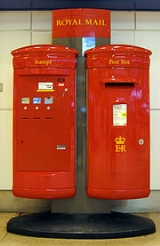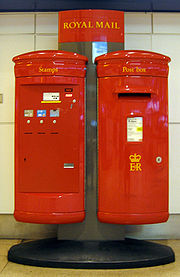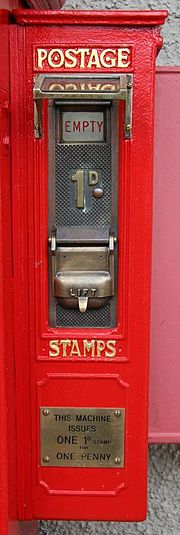
Stamp vending machine
Encyclopedia

A stamp vending machine (SVM) is a mechanical, electrical or electro-mechanical device which can be used to automatically vend postage stamp
Postage stamp
A postage stamp is a small piece of paper that is purchased and displayed on an item of mail as evidence of payment of postage. Typically, stamps are made from special paper, with a national designation and denomination on the face, and a gum adhesive on the reverse side...
s to users in exchange for a pre-determined amount of money, normally in coin. Most SVMs were positioned in public places to provide a useful service to customers when other sources of postage stamps, such as Post Office
Post office
A post office is a facility forming part of a postal system for the posting, receipt, sorting, handling, transmission or delivery of mail.Post offices offer mail-related services such as post office boxes, postage and packaging supplies...
s were closed. The term is often applied to the entire object as found attached to a pillar box
Pillar box
A pillar box is a free-standing post box. They are found in the United Kingdom and in most former nations of the British Empire, members of the Commonwealth of Nations and British overseas territories, such as the Republic of Ireland, Australia, India and Gibraltar...
or sited in a wall. The name Stamp Vending Machine only applies to the internal mechanism, the housing is described by the UK Post Office as a "case" and was supplied, installed and maintained separately. Many postal administrations around the world have used automatic stamp vending machines including the United States
United States
The United States of America is a federal constitutional republic comprising fifty states and a federal district...
, where private manufacturers began vending stamps from coils in 1908. Most countries of the Commonwealth of Nations
Commonwealth of Nations
The Commonwealth of Nations, normally referred to as the Commonwealth and formerly known as the British Commonwealth, is an intergovernmental organisation of fifty-four independent member states...
have issued stamps for use in Stamp Vending Machines, including Hong Kong
Hong Kong
Hong Kong is one of two Special Administrative Regions of the People's Republic of China , the other being Macau. A city-state situated on China's south coast and enclosed by the Pearl River Delta and South China Sea, it is renowned for its expansive skyline and deep natural harbour...
, New Zealand
New Zealand
New Zealand is an island country in the south-western Pacific Ocean comprising two main landmasses and numerous smaller islands. The country is situated some east of Australia across the Tasman Sea, and roughly south of the Pacific island nations of New Caledonia, Fiji, and Tonga...
and Malta
Malta
Malta , officially known as the Republic of Malta , is a Southern European country consisting of an archipelago situated in the centre of the Mediterranean, south of Sicily, east of Tunisia and north of Libya, with Gibraltar to the west and Alexandria to the east.Malta covers just over in...
.
As a matter of fact, many countries still use stamp vending machines. For instance, in Europe, France and Germany do. Their design, fairly modern, is similar to the kind of electronic interface you may find on a machine selling train tickets, or an ATM: a screen displays several buying options, possibly in different languages. A set of buttons on both sides of the screen allows to select the desired option. The process can involve several steps (i.e. first choosing the value of the desired stamps, then their number). These machines normally accept coins, and in France also debit cards. The French machine, located in post offices, can let the user weight the envelope so that the exact correct fare may be selected (depending on the destination country). The German machines, located either inside or outside post offices, don't feature a scale, but the user can type the value they want to see printed on the stamp, before selecting how many they want. The German machine doesn't give change in coins, but issues extra stamps with the remaining value. The French machines, however, do give exact change.
Early designs
In the UK, the earliest SVM was tested in the last years of the 19th Century, but there are no drawings or records appertaining to it and it was quickly withdrawn. The earliest production series machines were introduced under Edward VII in 1907 following experiments with a patented 1906 design by New Zealander Robert J Dickie which was demonstrated to the British House of LordsHouse of Lords
The House of Lords is the upper house of the Parliament of the United Kingdom. Like the House of Commons, it meets in the Palace of Westminster....
in 1907. Dickie licenced the sales rights to his new machine outside the British Empire
British Empire
The British Empire comprised the dominions, colonies, protectorates, mandates and other territories ruled or administered by the United Kingdom. It originated with the overseas colonies and trading posts established by England in the late 16th and early 17th centuries. At its height, it was the...
to Kermode & Co, who successfully sold it around the world. SVM mechanisms and cases are described by the UK Post Office using, rather confusingly, two separate alphabetical series of type letters to describe each one. Thus a machine may be described in the format of a "Type B4 mechanism in a Case Type K".

Coil stamp
A coil stamp is a type of postage stamp sold in strips one stamp wide. The name derives from the usual handling of long strips, which is to coil them into rolls, in a manner reminiscent of adhesive tape rolls...
roll joined vertically (IE head-to-tail). A number after the letter B denotes a particular pattern or variation in design for the machine. The coin value is indicated on a changeable metal plate near the coin slot as the value and coin size were now variable at the time of manufacture, but not once deployed in the field.
New types introduced
Following quickly from the Type’B’ designs came other combinations of coin-operated machine. In Type ‘C’, two ½d stamps were issued in exchange for one penny coin, whilst in Type ‘D’, one 2d stamp is vended in exchange for two penny coins. These four types all work with long continuous stamp coils. In Type ‘F’, the machine is set to dispense booklets of stamps. These were introduced for machine-vending shortly before the outbreak of World War IIWorld War II
World War II, or the Second World War , was a global conflict lasting from 1939 to 1945, involving most of the world's nations—including all of the great powers—eventually forming two opposing military alliances: the Allies and the Axis...
and eventually came to be the predominant type in use. Booklets were first tried out in 1935 as mixed-value booklets of King George V
George V of the United Kingdom
George V was King of the United Kingdom and the British Dominions, and Emperor of India, from 6 May 1910 through the First World War until his death in 1936....
Jubilee
Golden Jubilee
A Golden Jubilee is a celebration held to mark a 50th anniversary.- In Thailand :King Bhumibol Adulyadej, the world's longest-reigning monarch, celebrated his Golden Jubilee on 9 June 1996.- In the Commonwealth Realms :...
stamps in panes of four, interleaved with advertising. These Jubilee books were too large for machine vending at the time.
Heyday of the stamp vending machine
By 1970, there were about 50000 stamp selling machines being used in the UK and many more had been exported worldwide. The basic design remained unchanged from 1905 until 1970, when the Type ‘G’ series was introduced. G.1 was the first “modern” mechanism and was said by the manufacturer to be designed to fit in the old housings, although subsequent to the prototype it had to be modified and in any case was much deeper than the preceding designs so that it actually required its own specially designed case, designated Type U. Type G machines incorporated many novel features including a Perspex cover sealed from moisture over the stamp coil to prevent the stamps sticking together. In addition the mechanism was driven by the user lifting a large flap over the vend slot. This action primed the machine. It could be set to dispense any number of stamps from one to five against the insertion of a single coin, although in practice this was never done and all Type G machines vended a strip of five values. Initially these added up to 1 shillingShilling
The shilling is a unit of currency used in some current and former British Commonwealth countries. The word shilling comes from scilling, an accounting term that dates back to Anglo-Saxon times where it was deemed to be the value of a cow in Kent or a sheep elsewhere. The word is thought to derive...
, then after 1971, 5 new pence and by 1980, 10p. Changes in postal rates introduced in 1980 meant that all surviving 10p machines were withdrawn from service.
Construction and use
Types A-E share the same common features that contributed to their success; they all have a stamp feed wheel with pins which accurately interlock with the stamp perforationPerforation
A perforation is a small hole in a thin material or web. There is usually more than one perforation in an organized fashion, where all of the holes are called a perforation...
s and they all derive the energy needed to operate the mechanism from the raising of a weight through the insertion of a coin. Type F machines are different in that the coin releases a “Pull” bar which when pulled, forces the next booklet in a stack out through the vend slot. Such mechanisms as Type F and Type G are said to be “coin-freed”. This proved to be very successful and was used over and over again in subsequent designs of machine up to about 1988, when manufacture of purely mechanical SVMs ceased.
From that time all machines in use in the UK were of the electro-mechanical type. This used a standard mechanical coin-weigher unit and mechanical stacking for booklets, but had an electronic arm on a rotating cam
Cam
A cam is a rotating or sliding piece in a mechanical linkage used especially in transforming rotary motion into linear motion or vice-versa. It is often a part of a rotating wheel or shaft that strikes a lever at one or more points on its circular path...
for dispensing the booklets. They were manufactured by Hillday Automation of Attleborough
Attleborough
Attleborough is a market town and civil parish in Norfolk, England situated between Norwich and Thetford. The parish falls within the district of Breckland and has an area of 21.90 km² with a Mainline to both Norwich and Cambridge....
, Norfolk
Norfolk
Norfolk is a low-lying county in the East of England. It has borders with Lincolnshire to the west, Cambridgeshire to the west and southwest and Suffolk to the south. Its northern and eastern boundaries are the North Sea coast and to the north-west the county is bordered by The Wash. The county...
and designated Type B52. Two versions were built with either long or short coin boxes, easily recognised from the length of the case. Initially set to dispense 4 x 25p stamps in a folded booklet in exchange for a £1 coin, different combinations were later employed as postage rates in the UK continued to rise.
These electro-mechanical machines were powered by large internal battery
Battery (electricity)
An electrical battery is one or more electrochemical cells that convert stored chemical energy into electrical energy. Since the invention of the first battery in 1800 by Alessandro Volta and especially since the technically improved Daniell cell in 1836, batteries have become a common power...
packs which made them expensive to service and more unreliable than the purely mechanical designs. All of these were removed during 2001 and today there are far fewer automated stamp vending machines in use in the UK. As stamp booklets can now be widely purchased from supermarkets, garages, kiosks and newsagents, demand for automatic vending facilities has declined to the point where their continued operation becomes un-economic. Remaining machines are also found inside Post Offices, dispensing 1st and 2nd class NVI stamps from coils for those customers who wish to avoid queues.
Official documents
In 1949, the GPO were issuing Type B4 machines in 1/2d and 1d denominations, while by 1958 a B4 3d machine had been introduced. P.O. Engineering Dept. notice C.1003 was issued on 22 September 1949, which includes ink drawings to show how the B4 mechanism works. Notice C4111 details how to load it, while maintenance is covered by C5011 & C5164. These documents can be viewed at The British Postal Museum & ArchiveThe British Postal Museum & Archive
The British Postal Museum & Archive is the leading resource for all aspects of the history of the British postal system. It operates three sites: The Royal Mail Archive at Mount Pleasant sorting office in Clerkenwell, London, a Museum Store in Loughton, Essex and The Museum of the Post Office in...
in London.

